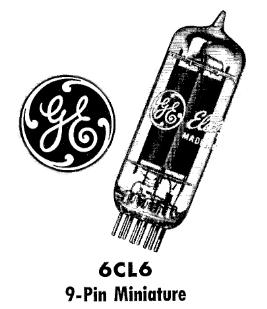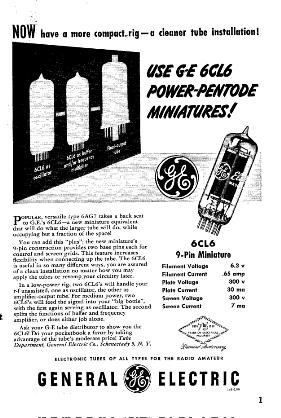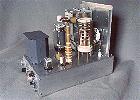

Won't just any tube work?
At first glance it would seem that just about any tube would function fine as
an oscillator, and to an extent this is true. But this isn't just any
oscillator, it is a keyed oscillator that is connected to an antenna and
subject to constant adjustment. The keying places severe limitations on the
performance of the oscillator if a decent sounding signal is desired. Direct
coupling to the antenna also affects the performance of the oscillator as well.
Without careful design, antenna coupling can cause slow starting of the
oscillator (that is, lousy keying!) and in some cases the oscillator may not
even work. The design of a one-tube (or one transistor) transmitter is a
compromise involving power output, keying, and the effect of antenna coupling
on operation. The design of the transmitter involves the type of circuit, the
choice of component values, and the choice of the particular tube used.
Why not use a big tube like a 6L6 and get lots
of output?
One of the most important things in obtaining good keying and a good CW note is
to keep the crystal current as low as possible consistent with adequate output.
This excludes "monster" type one-tube transmitters using a 6L6, 6146,
or TV sweep tubes like a the 6DQ5, 6CU6, and 6DQ6. These can give large output
(30w or more), but their keying is lousy and it is possible to destroy the
crystal with too much current. Still, such rigs were popular in the days when a
good sounding signal wasn't as important as having a strong signal on a budget.
I know, because I had one and it chirped like a bird and did a great job of
heating the crystals!
Why use an electron-coupled circuit, rather
than another type?
Keeping the crystal current low also dictates an
electron-coupled oscillator
circuit, which combines the functions of oscillator and amplifier into a
single tube. With an electron coupled oscillator circuit it is also possible to
obtain decent output (about 5w) while still keeping the crystal current low.
The electron-coupled circuit also provides a measure of isolation between the
load (antenna) and the oscillator.
The 6AG7 is highly recommended in an article in
the March, 1950 issue of QST
In 1950, an important article in QST magazine, "Crystal-Controlled
Oscillators, A Review of Modern Crystals, Circuits and Tubes" (QST, March
1950, C. Vernon Chambers, W1JEQ) addressed all of the issues above, as well as
the choice of which tube to use. In that article, various electron-coupled
circuits were tried along with a variety of tubes: the 6AG7, 6F6, 6V6GT, and
6L6. Among the many conclusions in the article, one came through loud and
clear, which I quote here: "Of the four tubes tested the 6AG7 is by far
the best from every standpoint." As a result of that article, virtually
all crystal oscillator circuits in the ARRL handbook for the next 15 years
featured or recommended the use of the 6AG7.
The 6CL6 is released by GE as the
miniature version of the 6AG7 in May, 1953
On the first page of the May, 1953 issue of QST, an ad appeared by GE
announcing the 6CL6 as the new, miniature replacement for the 6AG7. The new
6CL6 was the electrical equivalent of the 6AG7 in a cheaper, smaller, package:

Click On The Image Above For An Enlarged Version
So why use a 6CL6?
The 6CL6 was smaller, less expensive, and had the same performance and
specifications as the 6AG7. It would thus behave the same as the 6AG7 in any
circuit. So the choice of a 6CL6 was the result of the recommendations of a
1950 article in QST magazine, and the fact that the 6CL6 is the miniature
version of the 6AG7.
Why use regulated screen voltage?
The same article recommending the 6AG7 also stated, and I quote:
"Regardless of the circuit selection, use regulated screen voltage if good
keying is desired." Needless to say, very few (if any) of the crystal
oscillators in commercial gear produced in the 50's and 60's used regulated
voltage on the oscillator screen. Good, clean keying was not a top priority in
the 50's and 60's, so regulating the oscillator screen voltage was considered
an unnecessary expense. That's why many crystal-controlled tube rigs have a
well deserved reputation for lousy keying. (Note, however, that even with
regulated screen voltage, the right tube, and the right circuit, a poor crystal
will still result in poor keying!)
 Click here for pictures and information on the Wingfoot
VFO 2E26 Exciter
Click here for pictures and information on the Wingfoot
VFO 2E26 Exciter Click here for pictures and information on the Wingfoot
813 Amplifier
Click here for pictures and information on the Wingfoot
813 Amplifier Back to Dr.
Greg Latta's Electrical Engineering and Amateur Radio Pages
Back to Dr.
Greg Latta's Electrical Engineering and Amateur Radio Pages
 If you have any questions or
comments, you can send E-Mail to Dr. Greg Latta at
glatta@frostburg.edu
If you have any questions or
comments, you can send E-Mail to Dr. Greg Latta at
glatta@frostburg.edu
This page is under constant revision. Please check back often.